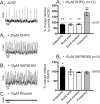Metabotropic glutamate receptors (mGluR5) activate transient receptor potential canonical channels to improve the regularity of the respiratory rhythm generated by the pre-Bötzinger complex in mice
- PMID: 22612431
- PMCID: PMC3370142
- DOI: 10.1111/j.1460-9568.2012.08091.x
Metabotropic glutamate receptors (mGluR5) activate transient receptor potential canonical channels to improve the regularity of the respiratory rhythm generated by the pre-Bötzinger complex in mice
Abstract
Metabotropic glutamate receptors (mGluRs) are hypothesized to play a key role in generating the central respiratory rhythm and other rhythmic activities driven by central pattern generators (e.g. locomotion). However, the functional role of mGluRs in rhythmic respiratory activity and many motor patterns is very poorly understood. Here, we used mouse respiratory brain-slice preparations containing the pre-Bötzinger complex (pre-BötC) to identify the role of group I mGluRs (mGluR1 and mGluR5) in respiratory rhythm generation. We found that activation of mGluR1/5 is not required for the pre-BötC to generate a respiratory rhythm. However, our data suggest that mGluR1 and mGluR5 differentially modulate the respiratory rhythm. Blocking endogenous mGluR5 activity with 2-Methyl-6-(phenylethynyl)pyridine (MPEP) decreases the inspiratory burst duration, burst area and frequency, whereas it increases the irregularity of the fictive eupneic inspiratory rhythm generated by the pre-BötC. In contrast, blocking mGluR1 reduces the frequency. Moreover, the mGluR1/5 agonist 3,5-dihydroxyphenylglycine increases the frequency and decreases the irregularity of the respiratory rhythm. Based on previous studies, we hypothesized that mGluR signaling decreases the irregularity of the respiratory rhythm by activating transient receptor potential canonical (TRPC) channels, which carry a non-specific cation current (ICAN). Indeed, 3,5-dihydroxyphenylglycine (DHPG) application reduces cycle-by-cycle variability and subsequent application of the TRPC channel blocker 1-[2-(4-methoxyphenyl)-2-[3-(4-methoxyphenyl)propoxy]ethyl]imidazole (SKF-96365) hydrochloride reverses this effect. Our data suggest that mGluR5 activation of ICAN-carrying TRPC channels plays an important role in governing the cycle-by-cycle variability of the respiratory rhythm. These data suggest that modulation of TRPC channels may correct irregular respiratory rhythms in some central neuronal diseases.
© 2012 The Authors. European Journal of Neuroscience © 2012 Federation of European Neuroscience Societies and Blackwell Publishing Ltd.
Figures







References
-
- Barthe JY, Clarac F. Modulation of the spinal network for locomotion by substance P in the neonatal rat. Experimental Brain Research. 1997;115:485–492. - PubMed
Publication types
MeSH terms
Substances
Grants and funding
LinkOut - more resources
Full Text Sources

